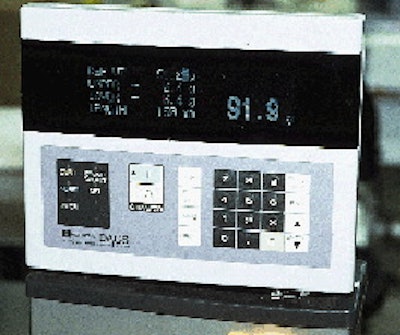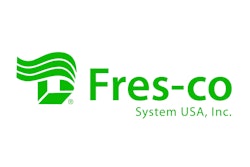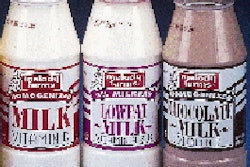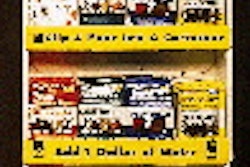Vitamins in a shiny gold vacuum-packed bag? It has never been done before, says Bryan Auxier, packaging manager at Amway's Nutrilite Div. And that's precisely why Nutrilite chose vacuum packaging for its premium Triple X vitamin and mineral products in preparation for its launch in Japan. Auxier explains: "We wanted to create something new, an esthetic look for the new market." The foil laminate material also provides an improved barrier for humid overseas shipping environments, according to Auxier. Shelf life of the foil-packed products is at least two years, according to the company. The products have been so successful in Japan that Nutrilite just purchased a second vacuum-packaging line-identical to the first, con-sisting of a f/f/s machine and vacuum-sealing chamber-in preparation for a product launch in Korea next spring. The new line had been running for only a week at Nutrilite's Buena Park, CA, manufacturing facility at the time of Packaging World's recent visit. But it was already operating at full output. The equipment is marketed by Unilogo, based in Milan, Italy, and is manufactured by the Italian company TME. Unilogo is represented in the U.S. by Boldt Technologies (West Des Moines, IA), which sold Nutrilite the packaging line and provides service. Preserving package equity The primary reason for the foil pouches is to capitalize on the equity already established by Nutrilite's patented polystyrene compartmented trays that hold the pouches. These hinged-lid trays have been in use for over 30 years and have accrued considerable recognition, in part because consumers often reuse the trays for storing household items. One compartment of the tray holds the gold pouch, which contains a month's supply of Amway's all-natural vitamin tablets (a total of 186 tablets, or two tablets three times a day for 31 days). A second compartment holds a silver pouch that contains an equal number of mineral tablets. The third component of Triple X consists of a high-density polyethylene bottle of soft gel capsules containing beta carotene, among other ingredients. The bottle and the PS tray are then packed into a paperboard tray with an attractively printed telescoping lid. (Eventually the HDPE bottle will be replaced by a third foil pouch, Auxier says, to be packed into a new, three-compartment PS tray.) Yes, the multiplicity of package components seems like it might be prohibitively expensive. But as Auxier points out, one package consists of a month's supply, and sells in Japan for the equivalent of about $100. So saving a few pennies here or there becomes less important than creating a high-quality look for the product, he says. That's especially true given the unique nature of Amway's distribution, which relies on personal multi-level marketing direct to consumers. These packages never compete for attention on a crowded store shelf. Marrying slat filling to f/f/s Aside from the uniqueness of the package, the actual packaging process is unusual since it couples a form/fill/seal machine with a tablet slat filler. The automated slat filler from Lakso Packaging Systems (Leominster, MA) sits atop the Unilogo/TME f/f/s machine. The line produces 34 vacuum bags per minute. "Unilogo wanted to work with Lakso [to ensure the two machines are properly designed to work together]," says Auxier, "so we got their engineers together. Lakso built the slat filler and it was sent to Italy where Unilogo married the two machines together." The line starts out as tablets are pneumatically conveyed from a ground-level hopper to a hopper on top of the slat filler. This hopper eliminates the need to climb to the mezzanine platform to replenish the filler. The standard slat filler relies on a continuous belt of slats to pick up tablets from the hopper as the slats cycle through the machine. It takes about five slats' worth of tablets to fill one bag. Nutrilite can operate the slat filler unattended because a checkweigher at the end of the line verifies the tablet count by weighing each bag. Bags are formed via a traditional form/fill/seal process on the Unilogo/TME machine. The laminate rollstock, supplied by Fres-Co System USA (Telford, PA), consists, from the outside, of 48-ga reverse-printed polyester/28-ga aluminum foil for barrier/60-ga oriented nylon for tear- and child-resistance/3-mil linear low-density polyethylene for heat-sealing. After the slats deposit the correct number of tablets into the open bag, the bag drops down into an oval racetrack-style conveyor with individual pockets for each bag. The bags index automatically into the vacuum chamber, which waits until 10 bags have accumulated for vacuum sealing. The chamber closes, pulls a vacuum of about 28" of mercury, and seals the bags. After some initial tinkering with the tablet formulation of what might seem like a fragile product, Nutrilite experiences no breakage of tablets either during the vacuum phase or subsequent shipping, Auxier says. "In production we found that one of the tablets was a little too soft. We made a formula change [to harden the tablet], and when we pull that vacuum, which is really strong, we experience no breakage. We've also done a lot of ship tests, and we still don't have any breakage." Sealed bags are laid on their sides by a special turning wheel designated for that purpose. Bags convey up an incline and over an Ishida checkweighing scale from Heat & Control (Hayward, CA) that verifies the correct count. Bags are then manually packed into in-process boxes for subsequent manual tray-loading, sealing and packing. Since only one bag size is filled, changeover of the machines was not an issue, according to Auxier. Good service Even though the machine was built by an overseas supplier, Auxier says service has been first-rate. He gives an example: "They re-engineered some sealing jaws that worked better for us and lowered our scrap rate." He credits "not only [their] work up front, but also their follow-up work to help us keep improving." Nor is there a problem obtaining parts. "With one call to Boldt, they'll contact Unilogo that night, and if it can be on the plane the next day or even if they have to machine something new, it's very short turnaround, especially considering that it's coming from the other side of the world," says Auxier. On the whole, he says the supplier never let distance interfere with its service commitments. "Quite the opposite," says Auxier. "They're in touch on a regular basis. That's why we went back and bought the second machine from them."



























